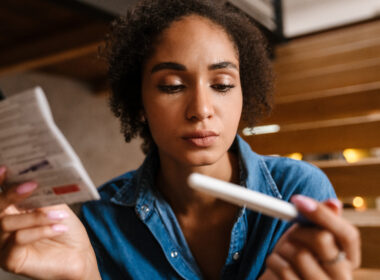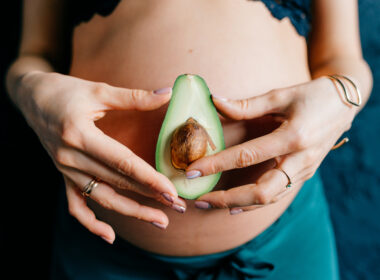In a previous article, I introduced the importance of all women understanding the effects that our cyclical hormones can play in our metabolism and insulin resistance [1]. But this becomes especially important for Type 1 diabetics, about half of whom experience elevated blood glucose levels in the days following ovulation [2]. Combined with what we know about the relative irregularity and unpredictability of teen cycles even without diabetes complications, this means that menstrual cycle phases should be taken into account when figuring out proper blood sugar management for teens with Type 1 diabetes [3].
What does cycle tracking look like for teen girls?
The simplest way to track ovulation is by learning how to observe changes in cervical fluid, also called cervical mucus. Cervical fluid is a biomarker (observable sign of something happening inside the body) that changes its appearance and feel in tandem with the rise and fall of estrogen, especially in the time surrounding ovulation. By charting cervical fluid patterns, girls and women can pay attention to how their insulin needs shift relative to estrogen surges (for example, do I need more insulin when I have a lot of clear, stretchy fluid?) and they can better assess changes to insulin needs in the days following a drying up of fluid, which would indicate that they are likely in the luteal phase after ovulation.
Teens can also learn how to chart basal body temperature (BBT), which shifts slightly higher following ovulation each cycle. Thanks to new technology, wearables like the Oura ring, Ava and TempDrop bracelets, and even earrings, can track your temp while you sleep, and some will sync with a smartphone app. Traditionally, BBT is a sign that would be utilized by NFP methods through either oral or vaginal temping, and those techniques are still the ones which have the best research behind them for family planning purposes [4]. But for simple cycle tracking to identify ovulation, it’s likely that teens would be able to utilize a wearable device like a smart watch to check temperature patterns in conjunction with cervical fluid in order to determine whether ovulation has passed [5].
Highly motivated girls may also choose to incorporate urine testing with luteinizing hormone strips (LH strips) to gain additional confidence. I tend not to recommend them for teens in general because of the ongoing cost, the level of commitment that is required for accurate testing, and the fact that many girls share bathrooms with siblings.
How and where to chart menstrual cycle signs and symptoms in tandem with blood sugar events
The accessibility of apps make it relatively easy to find a workable solution to keeping track of both cycle changes and insulin needs. Even a simple spreadsheet could be created and kept online or printed for your teen, if you’d prefer your teen avoid apps.
As your teen with Type 1 Diabetes is beginning to chart her menstrual cycle, I would recommend daily tracking of:
- Chosen cycle biomarkers
- % time in normal range for blood sugar levels
- Basal insulin dosage
- Bolus dosage
You can use the “notes” or “journal” feature of an app to log high or low blood sugar events that stood out. In some apps, girls can even save a screenshot of each 24-hour blood glucose graph for reference and review later on. One app which is particularly robust for this sort of customization and data storage is Read Your Body, which has the added bonus that it offers no automatic interpretation of cycles for your teen. This means that your teen tells the app when she is fertile based on her body’s signs, not the other way around.
Admittedly, investing in cycle knowledge to help manage Type 1 diabetes can feel a lot more overwhelming than simply picking up a prescription for birth control. But making this investment in the teenage years will lay an incredibly rich foundation for your daughter to know how to observe and track her insulin needs well into the future. She’ll already know how to manage her sugars in conjunction with her cycle if and when she decides to try and conceive later in life (imagine coming off of birth control with no idea how to adjust your insulin dosage!), plus she will be really well equipped to identify potential issues like PCOS or vaginal infections which are both more common in women with diabetes [6][7].
Here’s how to get your daughter with Type 1 Diabetes started with menstrual cycle charting
The good news is, you’ve got options for helping your teen with Type 1 diabetes learn how to chart her cycle to achieve stable blood sugar levels. I created the Charting for Girls handbook and Natural Womanhood has an excellent Mothers of (Pre) Teens online body literacy course. Other program options include the Mother Daughter program from Couple to Couple League, the Guiding Star Project’s Cycle Show and Charting Health for Young Women.
Still thinking about birth control for your teen with Type 1 diabetes? Click here to read why you might want to reconsider.
References:
[1] Lin, G., Siddiqui, R., Lin, Z. et al. Blood glucose variance measured by continuous glucose monitors across the menstrual cycle. npj Digit. Med. 6, 140 (2023). https://doi.org/10.1038/s41746-023-00884-x
[5] Shilaih, Mohaned et al. “Modern fertility awareness methods: wrist wearables capture the changes in temperature associated with the menstrual cycle.” Bioscience reports vol. 38,6 BSR20171279. 30 Nov. 2018, doi:10.1042/BSR20171279
[6] Héctor F. Escobar-Morreale, M. Belén Roldán-Martín; Type 1 Diabetes and Polycystic Ovary Syndrome: Systematic Review and Meta-analysis. Diabetes Care 1 April 2016; 39 (4): 639–648. https://doi.org/10.2337/dc15-2577 [7] Mohammed, Lubna et al. “The Interplay Between Sugar and Yeast Infections: Do Diabetics Have a Greater Predisposition to Develop Oral and Vulvovaginal Candidiasis?.” Cureus vol. 13,2 e13407. 18 Feb. 2021, doi:10.7759/cureus.13407Additional Reading:
How my fertility charts helped me customize my Type 1 Diabetes treatment







